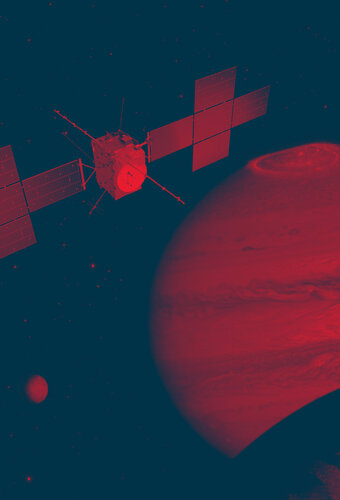Juice confirms that Earth is habitable
During its flyby of Earth on 20 August, ESA’s Jupiter Icy Moons Explorer (Juice) found ingredients for life in Earth’s atmosphere.
The flyby provided the opportunity to test out and calibrate Juice’s science instruments in space, ensuring that they are ready for arrival at Jupiter.
Two of Juice’s instruments – the Moons and Jupiter Imaging Spectrometer (MAJIS) and the Submillimetre Wave Instrument (SWI) – collected data that confirm Earth is habitable.

In this context, we’re defining ‘habitability’ as having conditions necessary to life to arrive and survive. Jupiter’s icy moons are particularly exciting prospects for life considering the oceans that hide beneath their surfaces.
During the Earth flyby, SWI 'listened' for the signals from hundreds of molecules in Earth’s atmosphere, including water and the so-called ‘CHNOPS’ elements (carbon, hydrogen, nitrogen, oxygen, phosphorous and sulphur). The CHNOPS elements are the most common ingredients of living organisms.
MAJIS also measured the composition of the atmosphere, detecting important molecules such as oxygen, ozone, carbon dioxide and water. Furthermore, the instrument imaged Earth’s surface in infrared light, resulting in information-rich temperature maps.
The MAJIS team is preparing to dig further into the data they collected during the Earth flyby, especially on the concentration of oxygen in the atmosphere. Their findings will help them discover whether the levels of oxygen would support current biological activity on Earth.

ESA Juice project scientist Olivier Witasse says: “We are obviously not surprised by these results… it would have been extremely concerning to find out that Earth was not habitable! But they indicate that MAJIS and SWI will work very successfully at Jupiter, where they will help us investigate whether the icy moons could be potential habitats for past or present life.”

Once at Jupiter, SWI will study the composition of the planet and its icy moons, telling us more about their current climates, their origin, and their history. The information that the instrument collects will reveal not only their potential habitability, but also capture signs of their current biological activities.
Meanwhile, MAJIS will observe Jupiter’s clouds and the ingredients in its atmosphere, and will investigate the thin atmospheres and ices and minerals on the surfaces of the icy moons.
SWI was developed and built by an international consortium of institutes led by the Max Planck Institute for Solar System Research (Germany). This development was supported by national funding agencies including DLR (Germany).
MAJIS was developed by a large consortium of European scientists and engineers, with two major contributions by France and Italy through the support of their respective space agencies, CNES and ASI. The main scientific contribution and responsibility are from the Institut d'Astrophysique Spatiale (France) and the National Institute for Astrophysics (Italy).















 Germany
Germany
 Austria
Austria
 Belgium
Belgium
 Denmark
Denmark
 Spain
Spain
 Estonia
Estonia
 Finland
Finland
 France
France
 Greece
Greece
 Hungary
Hungary
 Ireland
Ireland
 Italy
Italy
 Luxembourg
Luxembourg
 Norway
Norway
 The Netherlands
The Netherlands
 Poland
Poland
 Portugal
Portugal
 Czechia
Czechia
 Romania
Romania
 United Kingdom
United Kingdom
 Slovenia
Slovenia
 Sweden
Sweden
 Switzerland
Switzerland






























